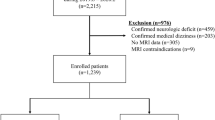Abstract
Purpose
To calculate the incidence of subsequent acute cerebrovascular syndrome in emergency department patients with vertigo or dizziness symptoms and to determine predictors of subsequent acute cerebrovascular syndrome in these patients.
Methods
Descriptive and retrospective hospital based-population study among emergency department patients with vertigo or dizziness symptoms in 1 year. One year follow-up since the medical visit was performed. Chi-square and Fisher tests were used for qualitative variables; Mann–Whitney U test for quantitative variables. A multivariate model was created.
Results
1243 dizzy patients who visited emergency department during 2015 were identified, finally 928 were included. 12 acute cerebrovascular syndromes were identified; 8 strokes and 4 transient ischemic attacks. Percentages over the sample size: 1.29% for acute cerebrovascular syndromes, 0.43% for transient ischemic attack and 0.86% for stroke. Odds ratio values to develop an event over the general population were 7.24 for acute cerebrovascular syndrome, 95% CI (3.98–13.12); 14.9 for transient ischemic attack, 95% CI (4.8–40.9) and 5.86 for stroke, 95% CI (2.72–12.0). Atrial fibrillation and diabetes mellitus were identified as significant risk factors to develop an acute cerebrovascular syndrome.
Conclusion
Emergency department patients with symptoms of vertigo or dizziness had sevenfold higher risk of acute cerebrovascular syndromes than the general population. Atrial fibrillation and diabetes mellitus are risk factors associated with high risk of acute cerebrovascular syndromes in these patients.


Similar content being viewed by others
References
Bisdorf A, Von Brevern M, Lempert T et al (2009) Classification of vestibular symptoms: towards an international classification of vestibular disorders. J Vestibul Res 19:1–13
Bisdorff A, Bosser G, Gueguen R et al (2013) The epidemiology of vertigo, dizziness, and unsteadiness and its links to co-morbidities. Front Neurol 4:29
Lammers W, Folmer W, Van Lieshout EM et al (2011) Demographic analysis of emergency department patients at the Ruijin Hospital, Shanghai. Emerg Med Int 2011:748274
Shahrami A, Norouzi M, Kariman H, Hatamabadi HR et al (2016) True vertigo patients in Emergency Department; an epidemiologic study. Emerg (Tehran) 4(1):25–28
Kerber KA et al (2009) Vertigo and dizziness in the Emergency Department. Emerg Med Clin North Am 27(1):39–50
Kim DR, Lee HJ, Kim HJ et al (2011) Dynamic changes in the inner ear function and vestibular neural pathway related to the progression of labyrinthine infarction in patient with an anterior inferior cerebellar artery infarction. Otol Neurotol 32:1596–1599
Lee CC, Ho HH, Su YC et al (2012) Increased risk of vascular events in emergency room patients discharged home with a diagnosis of dizziness or vertigo: a 3 year follow-up study. PLoS One 7(4):e35923
Kerber KA, Brown DL, Lisabeth LD, Smith MA, Morgenstern LB (2006) Stroke among patients with dizziness, vertigo, and imbalance in the emergency department: a population-based study. Stroke 37:2484–2487
Kim AS, Fullerton HJ, Johnston SC (2011) Risk of vascular events in emergency department patients discharged home with diagnosis of dizziness or vertigo. Ann Emerg Med 57:34–41
Díaz-Guzmán J, Egido-Herrero JA, Fuentes B et al (2012) Stroke and transient ischemic attack incidence rate in Spain: the IBERICTUS study. Cerebrovasc Dis 34(4):272–281
Kerber KA, Newman-Toker DE (2015) Misdiagnosing dizzy patients: common pitfalls in clinical practice. Neurol Clin 33:564–576
Savitz SI, Caplan LR, Edlow JA (2007) Pitfalls in the diagnosis of cerebellar infarction. Acad Emerg Med 14:63–68
Tohgi H, Takahashi S, Chiba K, Tohoku Cerebellar Infarction Study Group et al (1993) Cerebellar infarction. Clinical and neuroimaging analysis in 293 patients. Stroke 24:1697–1701
Funding
This study was not funded.
Author information
Authors and Affiliations
Corresponding author
Ethics declarations
Conflict of interest
None of the authors had conflict of interest in relation with the study.
Ethical standards
All procedures performed in studies involving human participants were in accordance with the ethical standards of the institutional and/or national research committee and with the 1964 Helsinki declaration and its later amendments or comparable ethical standards.
Rights and permissions
About this article
Cite this article
Mármol-Szombathy, I., Domínguez-Durán, E., Calero-Ramos, L. et al. Identification of dizzy patients who will develop an acute cerebrovascular syndrome: a descriptive study among emergency department patients. Eur Arch Otorhinolaryngol 275, 1709–1713 (2018). https://doi.org/10.1007/s00405-018-4988-2
Received:
Accepted:
Published:
Issue Date:
DOI: https://doi.org/10.1007/s00405-018-4988-2




